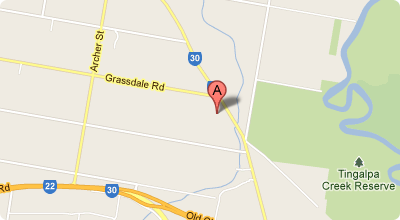Australian Habitats
Dry Sclerophyll Forest
Dry sclerophyll forests are characterised by their scenic landscapes and diverse flora and represent south-east Australia’s last remaining areas of wilderness.
Sclerophyll forests are a typically Australian vegetation type having plants (typically Eucalypts, Acacia’s and Banksia’s) with hard, short and often spikey leaves, which is a condition closely associated with low soil fertility (rather than rainfall/soil moisture). Low fertility also makes soils undesirable for agriculture and native vegetation has, therefore, remained relatively intact.
Plants grow slowly in nutrient-deficient conditions and some species have developed symbiotic relationships with nutrient-fixing bacteria and fungi to enhance nutrient availability. Others have root systems that increase the efficiency of nutrient uptake.
Bushfires play a vital role in regeneration of dry sclerophyll forests. Many species are able to resprout from buds protected beneath soils or within the trunk or branches. Other species have seeds that are protected by a hard seed-coat or woody fruit, which are stimulated to open or germinate by fire. The frequency, intensity, season of occurrence of fire (‘fire regime’) has an enormous effect on the composition and structure of these forests.
Wet Sclerophyll forests are tall, open forests and are generally found in higher rainfall areas on moister, more fertile soils and often borders rainforest areas. Wet Sclerophyll also have a well-developed understorey, containing some rainforest species such as ferns, palms and shrubs. Common plants species found in Wet Sclerophyll forests are Eucalyptus grandis, Eucalyptus acmenoides, Eucalyptus propinqua, Livistonia australis, and Lepidozamia sp.
Riparian Community
The Riparian zone is the strip of land along either side of a stream. Although there is some debate how wide this strip needs to be, it is established that a well-vegetated Riparian zone is important because of the potential benefits to the water quality, stream bank stability and stream ecology.
Riparian vegetation can reduce the amount of sediment and associated pollutants entering the stream. A well vegetated stream bank is resistant to stream bank erosion due to the extra stability provided by the roots and other plant material, and because it can reduce flow velocity at the edges of the stream.
Loss of Riparian vegetation, through clearing, livestock grazing or recreational uses, means that these benefits are lost and the overall condition of the stream can decline. For this reason, Riparian zone revegetation is an important aim of government agencies and many community groups.
Riparian bush is vegetation found along streams, creeks, rivers and wetlands. A variety of bush types make up Riparian vegetation, including rainforest, wet forest, dry forest and scrub. Riparian bush may have a grassy, heathy, sedgey or shrubby understorey. Some Riparian vegetation may be treeless. Alongside the stream there is often a strip of vegetation containing moisture-loving herbs, sedges, rushes and reeds that are periodically inundated. Within the stream are aquatic plants that are often referred to as macrophytes, which may float on the surface or emerge through it.
Sub – Tropical rainforest
The canopy of rainforests are generally closed and the trees densely spaced, in contrast to the open and scattered sclerophyllous vegetation that covers most of the forested area of the continent in the moister coastal and sub coastal zones.
Rainforest are described as “closed forest” because they have a canopy cover of 70% to 100%, consequently little sun reaches the forest floor. As a result only plants that are adapted to low light are able to flourish there.
Common plant species found in Sub- Tropical rainforest are Alectryon sp., Castanospermum sp., Elaeocarpus sp., Ficus sp.,
In tropical and sub-tropical rainforests there are three or more tree layers, with up to 60 species making up the canopy, many with large leaves. Rainforests are also distinguished from other forests by combinations of characteristic life forms e.g. epiphytes, lianes, certain root and stem structures, certain tree ferns and palms, absence of annual herbs on the forest floor.
Dry Rainforests
Dry rainforest occurs on relatively fertile soils in areas of lower rainfall and is widespread in western parts away from the coast of the Greater Brisbane Region.
Dry rainforests usually have a canopy that consists of two strata of trees, with the upper layer containing Acmena sp., Backhousia sp., or seasonally deciduous trees such as Flindersia sp., and Brachychiton sp. There may be 30 or more species of trees in the canopy, mostly with small, tough leaves. Palms epiphytes are uncommon, but lianes and prickly shrubs are more often common than found in Sub Tropical rainforest.
Wallum – Heathlands
The name Wallum was used by indigenous people in reference to Banksia aemula a small tree common in dry coastal heath. Heathlands occur on the stabilised sand dunes and Heaths are essentially treeless plant communities dominated by low shrubs and various other ground flora. Australian heaths are invariably associated with low nutrient soils deficient in phosphorus and nitrogen. Where the soils are well drained (for example, deep sands or skeletal sandstones or granites) dry-heathland prevails. Where the soils are subject to prolonged periods of high soil moisture a wetter type of heath develops. In lowland (typically coastal) situations these wetter forms of heath are simply termed “wet heaths” or “coastal wet heaths”.
Plant communities are typically rich in species with the major plant families represented including: myrtles (Myrtaceae), proteas (Proteaceae), wattles (Mimosaceae), peas (Fabaceae), lilies (Liliaceae), and grass-trees and mat-rushes (Xanthorrhoeaceae). In some situations wet heaths may grade into true sedgelands dominated by rushes (Juncaceae), sedges (Cyperaceae) and node-sedges (Restionaceae).
Heath shrubs typically have small, evergreen, sclerophyllous leaves that display a number of xenomorphic (structural change as a consequence of a physiological process concerning moisture) adaptations to combat moisture stress and/or anaerobic (without oxygen) soil conditions (for example, waxy leaf surfaces, leaf hairs, thick leaves), as well as extensive root systems, often arising from lignotubers. Xeromorphy is a common feature among wetland plants and there is some evidence that it may contribute towards the tolerance of plants to high soil wetness as well as drought.
Wetlands
Wetlands are areas of permanent or periodic/intermittent inundation, with water that is static or flowing fresh, brackish or salt, including areas of marine water, the depth of which at low tide does not exceed 6 metres. To be classified as a wetland, the area must have one or more of the following attributes:
- At least periodically, the land supports plants or animals that are adapted to and dependent on living in wet conditions for at least part of their life cycle, or
- The substratum is predominantly undrained soils that are saturated, flooded or ponded long enough to develop anaerobic conditions in the upper layers, or
- The substratum is not soil and is saturated with water, or covered by water at some time.
Wetlands are inherently dynamic systems that influence and are influenced by a complex range of environmental variables and undergo cycles of wetting and drying over temporal and spatial scales. Like most natural systems, no two wetlands are the same and as a result, distinguishing wetlands into meaningful, discrete types can be challenging.
Following are the different classifications of wetlands:-
- Marine (coastal wetlands including rocky shore) – plants commonly found are:- Crinum pedunculatum, Isolepis inundata, Juncus kraussii, Myoporum acuminatum
- Estuarine (including deltas, tidal marshes and mangrove swamps) – Avicennia marina, Sesuvium portulacastrum, Sporobolus virginicus,
- Riverine (wetlands along rivers and streams), Baumea rubiginosa, Carex appressa, Leperionia articulate, Schoenoplectus validus,
- Lacustrine (lakes and dams)
- Palustrine (marshes, swamps and bogs) wetlands.
Some of the above plants species can be found in one or more in the above areas of wetlands.
Coastal
There are two main types of frontal dunes,
Incipient frontal dunes – which develop when pioneer plant species trap and hold wind-borne sand; and Established frontal dunes – older dunes dominated by shrubs and trees and sheltered by a more recently formed frontal dune.
Frontal dunes have a protective role for adjacent coastal heath and rainforest communities by providing protection from sand movement and salt spray. Any loss of vegetation from frontal dunes will reduce the amount of sand deposited, and may exposure neighbouring plant communities to sand and saltwater intrusions.
Many of the plants found on frontal dunes have adaptations that enable them to withstand varying levels of exposure to salt spray, sun, wind and a moving sand surface. Although more than 50 plant species can be found on the seaward and landward profiles of frontal dunes, the following are the more common plant species that occur mainly on the seaward slopes:
- Spinifex hirsutus
- Lpomoea pes-capre
- Carpobrotus glauscens
- Casuarina equisetifolia
- Banksia integrifolia
More common plants that grow on the landward face of the frontal dunes, are:
- Acacia sophorae
- Cupanopsis anacardioides
- Dianella congesta
- Hibiscus tilaceus
- Westringia fruticosa
Grasslands
Grasslands are flat, open habitats covered mainly in grass, but also with other plants, wildflowers and a small number of trees and low shrubs. They receive less rainfall than forests and more than deserts. They contain many different kinds of grass Grasslands contain the most species of plants in Australia.
Grasses are plants that are found in every continent except Antarctica. They can grow from the coast to the tops of mountains. They are successful plants because of the way in which they grow: from the base of the plant rather than from the top. This means if grass is burned or eaten or walked on it is able to grow again easily from the bottom. They have long, thin leaves so they don’t lose moisture quickly, and their deep, thin roots help them to survive dry periods.
Today less than 1% of the native grasslands survives and is now considered one of the most threatened Australian habitats. An endangered habitat means animals as well as plants are threatened, many of the grasslands plant and animal species have become extinct and many more are now rare or threatened with extinction. As well as grasses such as Danthonia sp. and Themeda triandra, endangered grasslands plants include rare native orchids, lilies and pea plant species. A habitat such as grasslands includes animals that depend on the plants or physical environment. Much of the activity of grasslands occurs at or below ground level. Insects, small marsupials, reptiles and ground- dwelling birds live in grasslands. The clearing of huge areas of native vegetation, including grasslands and forests, to convert land for other uses is the main cause of the loss of biodiversity. It is also the main cause of land degradation in Australia. In some places, so much native vegetation has been removed that natural ecosystems are threatened. Some facts about the destruction of all kinds of native vegetation:
- More than 600,000 hectares of bushland in Australia is destroyed each year (90% in Queensland and New South Wales).
- Australia is one of the five main countries that clear the most native vegetation, including forests.
- There are about 2 million hectares of temperate grasslands in south-eastern Australian, but only about 10000 hectares is estimated to be in a viable condition.
- About 80% of woodlands in Victoria and NSW have been removed, to the degree where a number of animal species face extinction.
- About two-thirds of the Queensland Mulga lands and a large amount of the western NSW Mulga lands have been reduced or cleared.
- About 3% of temperate eucalypt woodlands remain in south eastern Queensland cleared for wheat.






